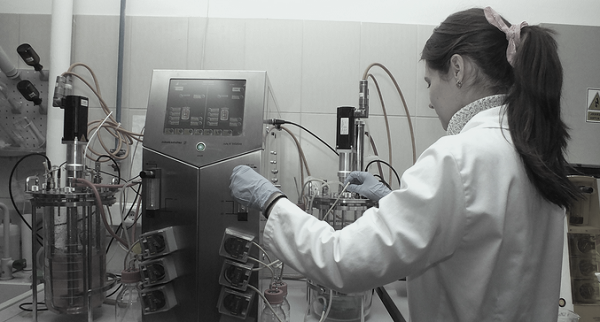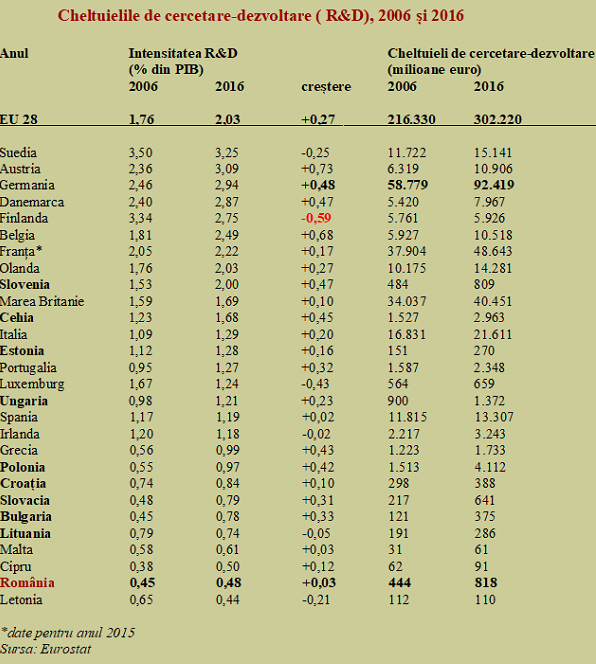 Romania ranked last year second to last among the EU member states in terms of R&D expenditure as a share of GDP. With only 0.48%, our country recorded in terms of allocations to this field less than a quarter of the EU average (2.03% of GDP).
Romania ranked last year second to last among the EU member states in terms of R&D expenditure as a share of GDP. With only 0.48%, our country recorded in terms of allocations to this field less than a quarter of the EU average (2.03% of GDP).
Paradoxically, though, we rank first in terms of government expenditure share in total research expenditure, which indicates a major suffering in the private sector.
The data released this week by Eurostat shows that we are among the countries with the lowest increase in the R&D spending over the last ten years, only + 0.03% of GDP and well below the effort made by similar countries such as Poland (+ 0.42%), Bulgaria (+ 0.33%) or Hungary (+ 0.23%).
We remind that the target set at the European level in the strategy for 2020 is 3% of GDP. Only two countries have reached this level, but it is worth noting the sustained effort made by Germany (+ 0.48% of GDP). The European locomotive increased the R&D spending by an impressive EUR 33.6 billion or + 57% over the last ten years, which explains, to a large extent, the German economic success.
At the opposite end, we have the situation in Finland, which has fallen from more than 3% of GDP below this level (although it maintained the nominal expenditure level somewhere below EUR 6 billion annually) and faces a not very happy economic situation. From here, we can see that maintaining the pace of growth in the R&D sector is essential and the capping costs, even in relation to the competition from other countries.
In order to get a synthetic idea of the gaps separating us from the European practice, we point out that Romania should allocate 12 times more to R&D than last year, to reach the target set for 2020, 8 times more to reaches the EU average and 4 times more to equal Poland’s level.
In the context, it should be stressed that Slovenia has achieved almost the EU average (it has reached the 2% of GDP threshold), the Czech Republic has been the strongest in the last ten years, placing itself immediately after the UK and Estonia got closer in terms of percentage of GDP to Italy. Even Bulgarian neighbours, who started at the same level with us at the moment of the EU accession, went up strongly (+ 0.33%, not + 0.03% like us), tripling the amounts allocated to the research field.
*
- Research and development spending, 2006 and 2016
- Year R&D intensity (share of GDP) growth Research and development spending (million euro)
*
Paradoxically, we are champions of the government sector share, with 33% of the total R&D spending but we are lacking in terms of higher education (11% compared to an EU average of 23%), with nominal values anyway very low if we consider the reporting base, affected by the low interest of the private sector.
By contrast, Slovenia (76%), Hungary (74%) and Bulgaria (73%) form the ranking of top countries where the private sector has the largest share in R&D spending (so not so much the state allocations are the key, but the creation of a stimulating environment for this type of business), which should give us food for thought.
In fact, research and development are very much in pain at the level of the Romanian private initiative and the systematic and methodical integration into the production processes is only an ambition. With only a few large centres of excellence created with some investment from multinationals it cannot be developed an economic sector increasingly important in this century, and without which we shall not be able to propagate the significant increase in the value added in the economy.
Alternately, we shall (possibly) obtain quantity in vain based on technologies and materials designed by others (by using the increasingly weaker asset of a relatively cheap labour), because we shall not be able to come up with the qualitative leap absolutely necessary for the sustainable income growth to the Western standard. With less than half a percent of GDP allocated to research, we cannot have expectations, despite the high economic growth of the moment.
It is a subject almost entirely lacking from the public debate.
Strategies for the country development abound in super offers for consumption, quantitative increases. But they do not bring incentives to the private sector for developing high added value products and services. That can only come from massive investment in R&D.










